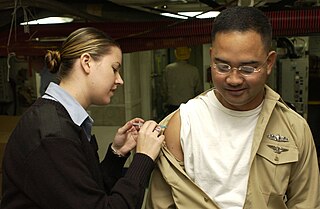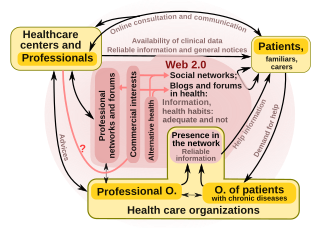Related Research Articles

Epidemiology is the study and analysis of the distribution, patterns and determinants of health and disease conditions in a defined population.
Text mining, text data mining (TDM) or text analytics is the process of deriving high-quality information from text. It involves "the discovery by computer of new, previously unknown information, by automatically extracting information from different written resources." Written resources may include websites, books, emails, reviews, and articles. High-quality information is typically obtained by devising patterns and trends by means such as statistical pattern learning. According to Hotho et al. (2005) we can distinguish between three different perspectives of text mining: information extraction, data mining, and a knowledge discovery in databases (KDD) process. Text mining usually involves the process of structuring the input text, deriving patterns within the structured data, and finally evaluation and interpretation of the output. 'High quality' in text mining usually refers to some combination of relevance, novelty, and interest. Typical text mining tasks include text categorization, text clustering, concept/entity extraction, production of granular taxonomies, sentiment analysis, document summarization, and entity relation modeling.

Avian influenza, also known as avian flu or bird flu, is a disease caused by the influenza A virus (IAV) which primarily affects birds but can sometimes affect mammals including humans. Wild aquatic birds are the primary host of Influenza A virus (IAV), which is endemic in many bird populations.

Influenza vaccines, colloquially known as flu shots, are vaccines that protect against infection by influenza viruses. New versions of the vaccines are developed twice a year, as the influenza virus rapidly changes. While their effectiveness varies from year to year, most provide modest to high protection against influenza. Vaccination against influenza began in the 1930s, with large-scale availability in the United States beginning in 1945.

Swine influenza is an infection caused by any of several types of swine influenza viruses. Swine influenza virus (SIV) or swine-origin influenza virus (S-OIV) refers to any strain of the influenza family of viruses that is endemic in pigs. As of 2009, identified SIV strains include influenza C and the subtypes of influenza A known as H1N1, H1N2, H2N1, H3N1, H3N2, and H2N3.
Public health surveillance is, according to the World Health Organization (WHO), "the continuous, systematic collection, analysis and interpretation of health-related data needed for the planning, implementation, and evaluation of public health practice." Public health surveillance may be used to track emerging health-related issues at an early stage and find active solutions in a timely manner. Surveillance systems are generally called upon to provide information regarding when and where health problems are occurring and who is affected.
Google Trends is a website by Google that analyzes the popularity of top search queries in Google Search across various regions and languages. The website uses graphs to compare the search volume of different queries over time.
An e-patient is a health consumer who participates fully in their own medical care, primarily by gathering information about medical conditions that impact them and their families, using the Internet and other digital tools. The term encompasses those who seek guidance for their own ailments, and the friends and family members who research on their behalf. E-patients report two effects of their health research: "better health information and services, and different, but not always better, relationships with their doctors."

Gunther Eysenbach is a German-Canadian researcher on healthcare, especially health policy, eHealth, and consumer health informatics.
The Journal of Medical Internet Research is a peer-reviewed open-access medical journal established in 1999 covering eHealth and "healthcare in the Internet age". The editors-in-chief are Gunther Eysenbach and Rita Kukafka. The publisher is JMIR Publications.

GISAID, the Global Initiative on Sharing All Influenza Data, previously the Global Initiative on Sharing Avian Influenza Data, is a global science initiative established in 2008 to provide access to genomic data of influenza viruses. The database was expanded to include the coronavirus responsible for the COVID-19 pandemic, as well as other pathogens. The database has been described as "the world's largest repository of COVID-19 sequences". GISAID facilitates genomic epidemiology and real-time surveillance to monitor the emergence of new COVID-19 viral strains across the planet.

"Health 2.0" is a term introduced in the mid-2000s, as the subset of health care technologies mirroring the wider Web 2.0 movement. It has been defined variously as including social media, user-generated content, and cloud-based and mobile technologies. Some Health 2.0 proponents see these technologies as empowering patients to have greater control over their own health care and diminishing medical paternalism. Critics of the technologies have expressed concerns about possible misinformation and violations of patient privacy.

Influenza-like illness (ILI), also known as flu-like syndrome or flu-like symptoms, is a medical diagnosis of possible influenza or other illness causing a set of common symptoms. These include fever, shivering, chills, malaise, dry cough, loss of appetite, body aches, nausea, and sneezing typically in connection with a sudden onset of illness. In most cases, the symptoms are caused by cytokines released by immune system activation, and are thus relatively non-specific.
Culturomics is a form of computational lexicology that studies human behavior and cultural trends through the quantitative analysis of digitized texts. Researchers data mine large digital archives to investigate cultural phenomena reflected in language and word usage. The term is an American neologism first described in a 2010 Science article called Quantitative Analysis of Culture Using Millions of Digitized Books, co-authored by Harvard researchers Jean-Baptiste Michel and Erez Lieberman Aiden.

Google Flu Trends (GFT) was a web service operated by Google. It provided estimates of influenza activity for more than 25 countries. By aggregating Google Search queries, it attempted to make accurate predictions about flu activity. This project was first launched in 2008 by Google.org to help predict outbreaks of flu.
Infodemiology was defined by Gunther Eysenbach in the early 2000s as information epidemiology. It is an area of science research focused on scanning the internet for user-contributed health-related content, with the ultimate goal of improving public health. Later, it is also defined as the science of mitigating public health problems resulting from an infodemic.
John Brownstein is a Canadian epidemiologist and Professor of Medicine at the Harvard Medical School as well as the Chief Innovation Officer at Boston Children’s Hospital. His research focuses on development of computational methods in epidemiology for applications to public health also known as computational epidemiology or e-epidemiology He is also the founder of several global public health surveillance systems including HealthMap. He is most known for his work on global tracking of disease outbreaks.
Participatory surveillance is community-based monitoring of other individuals. This term can be applied to both digital media studies and ecological field studies. In the realm of media studies, it refers to how users surveil each other using the internet. Either through the use of social media, search engines, and other web-based methods of tracking, an individual has the power to find information both freely or non freely given about the individual being searched. Issues of privacy emerge within this sphere of participatory surveillance, predominantly focused on how much information is available on the web that an individual does not consent to. More so, disease outbreak researchers can study social-media based patterns to decrease the time it takes to detect an outbreak, an emerging field of study called infodemiology. Within the realm of ecological fieldwork, participatory surveillance is used as an overarching term for the method in which indigenous and rural communities are used to gain greater accessibility to causes of disease outbreak. By using these communities, disease outbreak can be spotted earlier than through traditional means or healthcare institutions.

Neil Morris Ferguson is a British epidemiologist and professor of mathematical biology, who specialises in the patterns of spread of infectious disease in humans and animals. He is the director of the Jameel Institute, and of the MRC Centre for Global Infectious Disease Analysis, and head of the Department of Infectious Disease Epidemiology in the School of Public Health and Vice-Dean for Academic Development in the Faculty of Medicine, all at Imperial College London.
An infodemic is a rapid and far-reaching spread of both accurate and inaccurate information about certain issues. The word is a portmanteau of information and epidemic and is used as a metaphor to describe how misinformation and disinformation can spread like a virus from person to person and affect people like a disease. This term, originally coined in 2003 by David Rothkopf, rose to prominence in 2020 during the COVID-19 pandemic.
References
- ↑ Eysenbach, Gunther (2006). "Infodemiology: Tracking Flu-Related Searches on the Web for Syndromic Surveillance". AMIA Annual Symposium Proceedings. 2006: 244–8. PMC 1839505 . PMID 17238340.
- ↑ Eysenbach, Gunther (2002-12-15). "Infodemiology: The epidemiology of (mis)information". The American Journal of Medicine. 113 (9): 763–765. doi: 10.1016/s0002-9343(02)01473-0 . ISSN 0002-9343. PMID 12517369.
- ↑ Gunther Eysenbach (May 2011). "Infodemiology and infoveillance tracking online health information and cyberbehavior for public health". American Journal of Preventive Medicine . 40 (5 Suppl 2): S154–S158. doi: 10.1016/j.amepre.2011.02.006 . PMID 21521589.
- 1 2 3 4 5 Gunther Eysenbach (2009). "Infodemiology and infoveillance: framework for an emerging set of public health informatics methods to analyze search, communication and publication behavior on the Internet". Journal of Medical Internet Research . 11 (1): e11. doi: 10.2196/jmir.1157 . PMC 2762766 . PMID 19329408.
- ↑ Domnich, Alexander; Arbuzova, Eva K.; Signori, Alessio; Amicizia, Daniela; Panatto, Donatella; Gasparini, Roberto (2014). "Demand-based web surveillance of sexually transmitted infections in Russia". International Journal of Public Health. 59 (5): 841–9. doi:10.1007/s00038-014-0581-7. PMID 25012799. S2CID 23632100.
- ↑ Zhou, Xi-chuan; Shen, Hai-bin (2010). "Notifiable infectious disease surveillance with data collected by search engine". Journal of Zhejiang University Science C. 11 (4): 241–8. doi:10.1631/jzus.C0910371. S2CID 31424896.
- 1 2 Lampos, Vasileios; Cristianini, Nello (2010). "Tracking the flu pandemic by monitoring the social web". 2010 2nd International Workshop on Cognitive Information Processing. pp. 411–6. doi:10.1109/CIP.2010.5604088. ISBN 978-1-4244-6459-3. S2CID 5868871.
- ↑ Corley, Courtney D.; Cook, Diane J.; Mikler, Armin R.; Singh, Karan P. (2010). "Using Web and Social Media for Influenza Surveillance". Advances in Computational Biology. Advances in Experimental Medicine and Biology. Vol. 680. pp. 559–64. doi:10.1007/978-1-4419-5913-3_61. ISBN 978-1-4419-5912-6. PMC 7123932 . PMID 20865540.
- ↑ Wójcik, Oktawia P; Brownstein, John S; Chunara, Rumi; Johansson, Michael A (2014-06-20). "Public health for the people: participatory infectious disease surveillance in the digital age". Emerging Themes in Epidemiology. 11 (1): 7. doi: 10.1186/1742-7622-11-7 . ISSN 1742-7622. PMC 4078360 . PMID 24991229.
- ↑ Ginsberg, Jeremy; Mohebbi, Matthew H.; Patel, Rajan S.; Brammer, Lynnette; Smolinski, Mark S.; Brilliant, Larry (2008). "Detecting influenza epidemics using search engine query data". Nature. 457 (7232): 1012–4. doi: 10.1038/nature07634 . PMID 19020500. S2CID 125775.
- ↑ Lampos, Vasileios; Miller, Andrew C.; Crossan, Steve; Stefansen, Christian (3 Aug 2015). "Advances in nowcasting influenza-like illness rates using search query logs". Scientific Reports. 5 (12760): 12760. Bibcode:2015NatSR...512760L. doi:10.1038/srep12760. PMC 4522652 . PMID 26234783.
- ↑ Lazer, David; Kennedy, Ryan; King, Gary; Vespignani, Alessandro (2014-03-14). "The Parable of Google Flu: Traps in Big Data Analysis" (PDF). Science. 343 (6176): 1203–1205. Bibcode:2014Sci...343.1203L. doi:10.1126/science.1248506. ISSN 0036-8075. PMID 24626916. S2CID 206553739.
- ↑ Chan, Emily H.; Sahai, Vikram; Conrad, Corrie; Brownstein, John S. (2011). Aksoy, Serap (ed.). "Using Web Search Query Data to Monitor Dengue Epidemics: A New Model for Neglected Tropical Disease Surveillance". PLOS Neglected Tropical Diseases. 5 (5): e1206. doi: 10.1371/journal.pntd.0001206 . PMC 3104029 . PMID 21647308.
- ↑ Romero-Alvarez, Daniel; Parikh, Nidhi; Osthus, Dave; Martinez, Kaitlyn; Generous, Nicholas; del Valle, Sara; Manore, Carrie A. (2020-03-26). "Google Health Trends performance reflecting dengue incidence for the Brazilian states". BMC Infectious Diseases. 20 (1): 252. doi: 10.1186/s12879-020-04957-0 . ISSN 1471-2334. PMC 7104526 . PMID 32228508.
- ↑ "Using symptoms search trends to inform COVID-19 research". Google. 2020-09-02. Retrieved 2021-02-15.
- ↑ Lampos, Vasileios, Cristianini, Nello (2012). "Nowcasting Events from the Social Web with Statistical Learning". ACM Transactions on Intelligent Systems and Technology. 3 (4): 1–22. doi:10.1145/2337542.2337557. S2CID 8297993.
{{cite journal}}: CS1 maint: multiple names: authors list (link) - ↑ "Re-Identification of "Anonymized" Data". Georgetown Law Technology Review. 2017-04-12. Retrieved 2021-02-15.